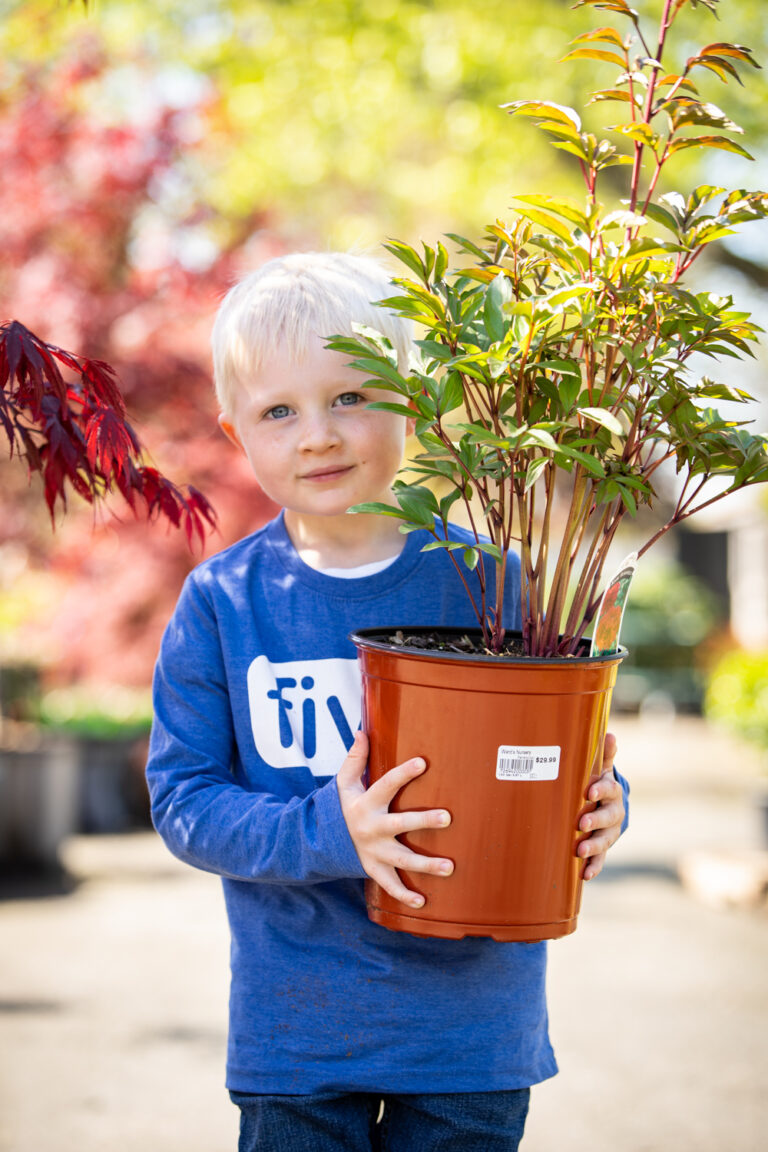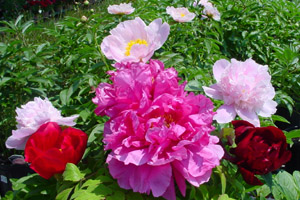Peony Planting

HERBACEOUS PEONY-PLANTING & CARE
Potted peonies alleviate much of the stress and concern over peony planting because you can plant pot-grown peonies any time of the growing season as long as the plants enjoy good drainage and regular watering.
CHOOSE A GOOD LOCATION
Peony bushes (paeonia lactiflora) flourish in full or partial sun exposure. Plants require at least five hours of direct sunlight to bloom. Specimens require well-drained soil with a pH range of 6.5 to 7.5 and plenty of space to grow and flower. Space plants at least 3 to 4 feet from one another to reduce competition for soil nutrients and water and encourage good flowering.
- Water the peony thoroughly before planting.
- Dig a hole AT LEAST TWICE AS DEEP AND AS WIDE as the root ball or container.
- Make a mixture of 1 part soil, 1 part peat moss and 1 part composted cow manure for use in the planting hole. A scoop of bonemeal and superphosphate helps too.
- Return some soil mixture to the hole so that the potted peony’s soil will sit evenly with ground level. If you have a bare root, the buds or eyes of the rootstock should be approximately 2” below the soil level, no deeper.
- For potted peonies, carefully remove root ball from the plastic pot. Place one hand on top of soil; turn pot upside down; grasp bottom of pot and lift up, cleanly removing pot from soil.
- Set peony in the hole and confirm that the potted soil level is even with the ground level. Adjust by removing or adding soil mixture.
- Backfill with the remaining soil mixture.
- Water thoroughly especially if planting bareroot stock. Wait for water to percolate down and soil to settle. Add more soil mixture if necessary then water again.
Care after planting:
- Spread ¼ cup Flower-Tone or similar fertilizer with ratio of N-P-K similar to 5-8-8 in a circle around the plant and scratch in slightly. The ratio is important because too much nitrogen will encourage leaves and not flowers. Fertilize at planting, again in September and then twice annually in April and September
- Install a single or double peony hoop around the bush to support heavy blooms.
- Spread 1 – 2 inches of mulch around the plant to help retain soil moisture.
- Water surrounding soil deeply once a week through October.
- Spray if necessary (during high humidity conditions) with general purpose fungicide 2 or 3 applications 10 days apart (follow label directions).
- Cutting center blooms will encourage side-buds to mature and bloom, extending flowering period.

Keys to Continued Success:
- In October, weed and clear debris from around the plants. After a hard frost, cut yellowed stems to the ground level. Bag up and destroy (not compost) any debris to prevent over-wintering diseases and pests.
- After several frosts but before the ground freezes—generally by late-November—mound mulch up to 6 inches over the plant. This prevents root injury that results from rapid temperature changes in winter. These fluctuations heave plants out of the ground and expose roots and plant crowns to the drying winds of winter.
- By mid-April, remove the deep mulch, exposing the soil surface to ensure that light reaches the peony buds or eyes under the soil surface.
- Install a peony hoop or growing grid 12-18 inches over the plant as it emerges. This allows the peony to grow into its stake and you will have less chance of damaging the plant by struggling with heavy flowers or bushy stems too late in the season.
Trouble-shooting:
The American Peony Society has listed some reasons and possible solutions why peonies fail to flower well.
No buds appear:
- Plants too young and immature.—Allow them to mature.
- Planted too deep or too shallow.—Examine and if eyes are more than 3” below ground, lift and replant.
- Clumps too large and too old.—Divide the clump if it stops flowering (after3-10 years) leaving 3 eyes per division.
- Too much nitrogen.—Cut down on frequency of fertilizing or change fertilizer to different ratio.
- Moved and divided too often.—If the clump is flowering well it should not be moved. Clumps can remain in place well over 10 years.
- Too much shade.—Move to a sunny location.
Buds appear but flowers do not develop:
- Buds killed by late frost.—Hope for more seasonable weather next year. Or Plant earlier cultivars.
- Buds killed by disease. They usually turn black and die.—Spray as directed for botrytis.
- Buds attacked by thrips. They open partially, turn brown and fall.—Spray preventive oil as directed.
- Buds waterlogged due to excessive rain.—Plant singles or Japanese forms. Or Bagging buds will help.
- Plants undernourished.—Fertilize with 8-8-8 and bonemeal.
- Excessively hot weather.—Plant early flowering cultivars.
Spring Gardening Tips
The garden is waking up, and you're in charge! It's time to start planting, pruning, and preparing your flower beds.
Spring Articles